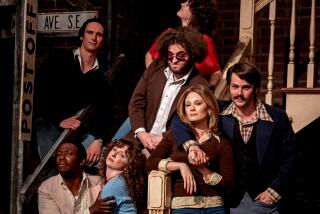‘Manson’ gets lost in guru’s dashed dreams
- Share via
The term “crime of the century” has been worn thin by overuse, but the slaughter of seven people in two days by members of the Manson family in August 1969 still requires its hyperbolic ring. The Tate-LaBianca murders scared Los Angeles witless and horrified an already deeply unsettled nation. Forty years later, Charles Manson remains our homegrown image of Satan and, as the recent denial of the dying Susan Atkins’ request for early release proves, the senselessly brutal deaths, particularly that of the pregnant Sharon Tate, are a still vivid American nightmare.
So it’s not surprising that the History cable channel would have some way of marking the anniversary. “Manson,” which premieres tonight, is a dramatically reenacted documentary that turns on the emergence of Linda Kasabian, a “family” member who was present at both murder sites. She did not actively participate in the killings and in exchange for immunity became prosecutor Vincent Bugliosi’s star witness during the Manson trial.
Kasabian, who has been in hiding for much of her adult life, left an unhappy marriage when she was 21, took her baby daughter and followed friend Catherine Share (a.k.a. Gypsy) to Manson’s Spahn Ranch. There she became romantically involved with Tex Watson and a devoted member of the “family” until she fled, leaving her daughter behind, shortly after the LaBianca murders.
As promising as the “emerges-from-hiding” interview might seem, the result quickly becomes just another excuse to wallow around in Manson lore and dramatically reenact the horrific murders.
Filmed in shadow, Kasabian sheds absolutely no light on how Manson managed to turn a group of hippie kids into butchers; we “learn” that he was very charismatic and that sex and drugs were involved, but it’s as if she were simply reading the published accounts of life on the ranch.
Her retelling of the Tate murders in particular is simplified and sanitized. While History has no problem splashing the camera lens with blood on many of its programs, here we are mercifully spared the well-documented mayhem. Unfortunately, the abbreviated scene -- the murders, particularly at the Tate house, appear to have taken minutes -- makes Kasabian’s doing nothing to stop them seem more reasonable than perhaps it was.
Although Bugliosi is on hand to explain Manson’s famous plans to start a race war, the narrative dwells instead on Manson’s failed attempts to become a music star. Tate’s house had previously been occupied by Terry Melcher, a record producer Manson met through Beach Boy Dennis Wilson. Melcher had made some noise about a record deal; when that turned out to be a typical Hollywood runaround, Manson went ballistic. That Roman Polanski and his wife now lived in the house didn’t matter at all.
Like the lamentable “Max” -- if only the German art world had recognized the talents of young Adolf Hitler, the Holocaust would have been averted -- “Manson” spends far too much time trying to figure out Manson, who was a self-proclaimed psychopath, and not enough time asking Kasabian how the line between robbery and carnage was so easily crossed by her lover and the women with whom she lived.
The mystery at the heart of the crimes was never Manson’s motivations -- he’s a psychopath -- but the infectious nature of his insanity. That darkness remains undisturbed by what little is revealed here.
--
--
‘Manson’
Where: History
When: 9 tonight
Rating: TV-PG (may be unsuitable for young children)
More to Read
The complete guide to home viewing
Get Screen Gab for everything about the TV shows and streaming movies everyone’s talking about.
You may occasionally receive promotional content from the Los Angeles Times.







